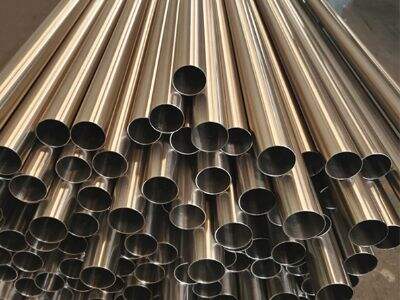硬さ試験は通常、特定の材料の硬さや強度を決定するために使用されます。この試験により、材料が引っかき傷、へこみ、または破損に対してどれだけ抵抗できるかを定義できます。ステンレス鋼管の硬さについて知ることは非常に重要です。私たちはこの理解を活用して、使用中に管が折れないほど堅いか確認します。泰鋼プーシンは専門メーカーです。今日は、より実用的なパイプの硬さをテストする方法をご紹介します。 ステンレスパイプ 製造業者です。今日は、より実践的なパイプの硬さを測定する方法を紹介します。
硬さ試験とは何ですか?
では、ステンレス鋼管の硬度テストを始める前に、まず硬度テストとは何かについて理解しましょう。硬度テストとは、材料に工具を押しつけて、その材料がどれだけの圧力に耐えられるかを測定するものです。材料が硬ければ硬いほど、押しつけに対して抵抗があります。硬度を測定するためのいくつかの一般的な方法がありますが、ここでは最も一般的な硬度テストであるロックウェル硬度テストについて説明します。この手法は、簡潔で有用な結果を提供するため広く使用されています。
ロックウェル硬度テスト
したがって、ロックウェル硬度試験法は、ステンレス鋼管の硬さを測定する非常に優れた方法です。この試験では、2種類のインデント器具(押圧工具)が使用されます。一つはダイヤモンドコーン、もう一つは鋼球です。さらに、この試験では2種類の異なる荷重——小荷重と大荷重——が適用されます。これらの荷重を使用して鋼の硬さを決定します。ロックウェル硬度スケールはAからCまでのシリーズで、Cが最も硬いレベルです。ロックウェルCスケールは一般的に使用され、 ステンレスパイプ 試験において最良の硬さに関する情報を提供します。
ロックウェル硬度試験の古典的な方法
したがって、ステンレス鋼管の硬さを確認するには、実際には溶剤と呼ばれる建設用クリーニングエージェントを使用して、最終テストを行う前にステンレス鋼管の表面を清掃する必要があります。これは、評価しやすく、より正確で信頼性のあるテスト結果を得られる清潔な表面を作り出すのに役立ちます。その後、この作業のために機械を用意する必要があります。具体的にはロックウェル硬度計です。再び申し上げますが、試験対象のステンレス鋼の種類に基づいて、適切なインデントや負荷を選択する必要があります。テストを開始する前に、測定器が適切に設定され、校正されていることを確認する必要があります。
ステンレス鋼管を試験機に適合するかどうか確認しています。管がインデントの直下で水平かつ中央に位置していることは非常に重要です。このように配置することで、最も正確な測定値を得ることができます。そして、小さな負荷をかけて管に小さなくぼみを作ります。これにより、さらなるストレスをかける前に開始点を回復することができます。次に、重い負荷をかけてより深いくぼみを作り、そのくぼみの深さを測定します。ロックウェル硬さ数は、主負荷と副負荷におけるくぼみの深さの差から計算されます。最後に、ロックウェルC硬さ数を参照して、どれほど硬いかを判断します。 ステンレスパイプ .
試験結果に影響を与える要因
これが、時々ステンレス鋼管の硬さをテストすると異なる結果になる理由です。いくつかの要因が結果に影響を与える可能性があります。パイプの表面仕上げはその一つの要因です。これは、滑らかな表面の方が粗い表面よりもより良いかつ正確な結果を得られるためです。表面仕上げが不十分だと、硬さの誤った読み取りにつながる可能性があります。パイプの厚さや、金属の変形や変更もまた、出力に変動を生じさせることがあります。これらの変化は製造または取り扱い中に起こることがあります。最適で正確な結果を得るためには、これらの要因を考慮に入れる必要があります。
なぜ硬さ試験が重要か?
硬いステンレス鋼管とは何かを認識することが重要です。これにより、設計された作業に耐えられる十分な強度があることが保証されます。もしパイプが硬さに欠けていれば、簡単に壊れたり曲がったりします。これは、この構造で使用される配管に漏れや故障が発生する原因となります。しかし、パイプが过硬であれば、扱いにくい場合があります。狭い場所に適合したり、他のパイプと接続するために必要な柔軟性が不足している可能性があります。ステンレス鋼管の硬さはまた、品質が良く、相当長い期間持つことを確認するためにもテストすることができます。
硬さのテスト:ステンレス鋼管を使用する際の重要なツール
泰钢普信は、最高の品質を提供するために最良の製品をお届けすることに全力を尽くしています。その方法の一つとして、私たちのパイプの硬さをテストしています。ここでは、皆さんがステンレス鋼パイプの硬さテストを自信を持って行えるよう、いくつかの手順を共有します。自分自身への注意点としては、結果を歪める可能性のある変数に留意し、テスト対象の特定のステンレス鋼グレードに適したテスト方法を使用することです。これにより、パイプが現在の状態で使用可能であることが保証されます。

 JA
JA
 EN
EN
 AR
AR
 BG
BG
 HR
HR
 CS
CS
 DA
DA
 NL
NL
 FI
FI
 FR
FR
 DE
DE
 EL
EL
 HI
HI
 IT
IT
 KO
KO
 NO
NO
 PL
PL
 PT
PT
 RO
RO
 RU
RU
 ES
ES
 SV
SV
 CA
CA
 TL
TL
 IW
IW
 ID
ID
 LV
LV
 LT
LT
 SR
SR
 SK
SK
 SL
SL
 UK
UK
 VI
VI
 GL
GL
 HU
HU
 MT
MT
 TH
TH
 TR
TR
 FA
FA
 MS
MS


